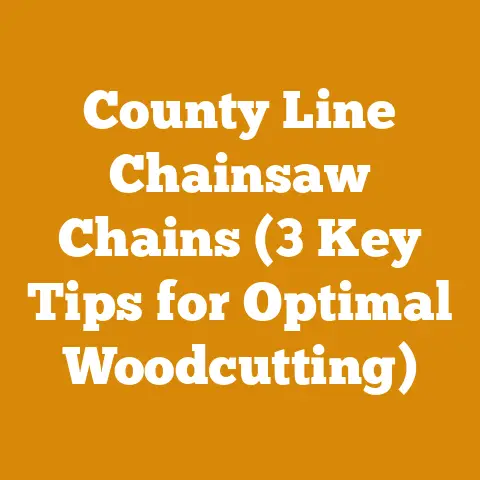Husqvarna 20″ Guide Bars for 460 (Pro Guide Bar Insights)
Let’s dive into the world of Husqvarna 20″ guide bars, specifically tailored for the Husqvarna 460 Rancher. One aspect I particularly appreciate about these bars is their ease of care. Regular cleaning and proper lubrication go a long way in extending their lifespan and ensuring optimal performance.
Understanding the Husqvarna 460 Rancher and Guide Bar Compatibility
The Husqvarna 460 Rancher is a workhorse of a chainsaw, popular among both homeowners and professionals for its versatility and power. It’s designed to handle a wide range of tasks, from felling small trees to bucking firewood. But, to truly unlock its potential, you need the right guide bar.
- Why 20 Inches? The 20″ bar length is often considered a sweet spot for the 460 Rancher. It provides ample reach for felling trees up to around 16-18 inches in diameter while maintaining maneuverability for smaller tasks. Shorter bars sacrifice reach, while longer bars can strain the saw’s engine and reduce cutting speed.
- Compatibility is Key: Not all 20″ bars are created equal. You need a bar that’s specifically designed to fit the Husqvarna 460 Rancher’s mounting pattern and chain pitch. Using an incompatible bar can lead to poor performance, premature wear, and even damage to your saw. The 460 Rancher typically uses a .325″ pitch chain with a .050″ gauge. Always double-check these specifications before purchasing a new bar.
Types of 20″ Guide Bars for the Husqvarna 460 Rancher
There are several types of 20″ guide bars compatible with the Husqvarna 460 Rancher, each with its own advantages and disadvantages in terms of cost, performance, and durability.
- Laminated Bars: These are the most common and generally the most affordable type. They consist of multiple layers of steel welded together. Laminated bars are lightweight and relatively durable, making them a good choice for general-purpose use.
- Cost: Typically range from $30 to $60.
- Pros: Lightweight, affordable, good for general use.
- Cons: Can be more prone to bending or damage compared to solid bars.
- Solid Bars: Solid bars are made from a single piece of steel, making them significantly stronger and more resistant to bending or damage. They are often preferred by professional loggers and those who frequently work with hardwoods.
- Cost: Typically range from $70 to $150.
- Pros: Highly durable, resistant to bending, ideal for heavy-duty use.
- Cons: Heavier than laminated bars, more expensive.
- Hard Nose Bars: These bars have a replaceable sprocket nose, which reduces friction and extends the life of the bar. Hard nose bars are a good choice for those who frequently cut dirty or abrasive wood.
- Cost: Typically range from $80 to $160.
- Pros: Reduced friction, extended bar life, good for cutting dirty wood.
- Cons: More expensive than laminated bars, requires occasional sprocket replacement.
Cost Breakdown: Purchasing a Husqvarna 20″ Guide Bar
Let’s break down the cost factors involved in purchasing a Husqvarna 20″ guide bar for your 460 Rancher. This analysis will help you understand the total cost of ownership and make informed decisions.
- Initial Purchase Price: As mentioned above, the initial purchase price varies depending on the type of bar you choose. Laminated bars are generally the most affordable, while solid and hard nose bars are more expensive.
- Chain Costs: A new guide bar often necessitates a new chain, especially if your old chain is worn or doesn’t match the bar’s specifications. Chains for a 20″ bar on a 460 Rancher typically cost between $20 and $40, depending on the quality and type of chain.
- Shipping Costs: Don’t forget to factor in shipping costs, especially if you’re ordering online. Shipping can add an additional $10 to $20 to the total cost.
- Sales Tax: Sales tax will vary depending on your location. Be sure to factor this into your budget.
- Installation Costs (Optional): If you’re not comfortable installing the bar and chain yourself, you may need to pay a professional to do it for you. This typically costs between $10 and $20.
Example Cost Scenario:
Let’s say you’re purchasing a laminated 20″ guide bar for $45, a new chain for $30, and shipping is $15. Assuming a sales tax rate of 7%, your total cost would be:
- Bar: $45
- Chain: $30
- Shipping: $15
- Subtotal: $90
- Sales Tax (7%): $6.30
- Total Cost: $96.30
Factors Influencing Guide Bar Pricing
Several factors influence the pricing of Husqvarna 20″ guide bars. Understanding these factors will help you navigate the market and find the best value for your money.
- Material Quality: The type and quality of steel used in the bar’s construction significantly impact its price. High-quality steel is more durable and resistant to wear, but it also comes at a higher cost.
- Manufacturing Process: The manufacturing process also plays a role in pricing. Solid bars, which require more complex manufacturing processes, are generally more expensive than laminated bars.
- Brand Reputation: Established brands like Husqvarna often command a premium price due to their reputation for quality and reliability.
- Retailer Markup: Different retailers have different markup policies, which can affect the final price. It’s always a good idea to shop around and compare prices from different sources.
- Supply and Demand: Like any product, the price of guide bars can fluctuate based on supply and demand. During peak seasons, prices may be higher due to increased demand.
Maintenance Costs: Extending the Life of Your Guide Bar
Proper maintenance is crucial for extending the life of your guide bar and minimizing your overall costs. Neglecting maintenance can lead to premature wear and damage, requiring you to replace the bar more frequently.
- Regular Cleaning: Regularly clean your guide bar to remove sawdust, pitch, and other debris. This will help prevent friction and wear. I typically use a wire brush and solvent to clean my bars after each use.
- Proper Lubrication: Ensure your bar is properly lubricated. Insufficient lubrication can lead to excessive friction and heat, causing the bar to wear out quickly. Always use a high-quality bar and chain oil.
- Chain Tension: Maintain proper chain tension. A chain that is too loose can cause excessive vibration and wear on the bar, while a chain that is too tight can cause the bar to overheat.
- Bar Rail Maintenance: Regularly check the bar rails for wear and damage. If the rails are worn or damaged, you can use a bar rail dresser to restore them.
- Flipping the Bar: Periodically flip the bar over to ensure even wear on both sides. This will help extend the bar’s life.
Cost of Maintenance:
- Bar and chain oil: $10-$20 per gallon. A gallon typically lasts me several months, depending on usage.
- Bar rail dresser: $15-$30. A one-time purchase that can last for years.
- Cleaning solvents: $5-$10 per can.
Performance Considerations: Matching the Bar to Your Needs
The type of guide bar you choose should be based on your specific needs and the types of tasks you’ll be performing.
- Wood Type: If you frequently cut hardwoods, a solid bar is a better choice due to its increased durability. For softer woods, a laminated bar may suffice.
- Cutting Frequency: If you use your chainsaw frequently, a more durable bar like a solid or hard nose bar will likely be a better investment in the long run.
- Cutting Conditions: If you frequently cut dirty or abrasive wood, a hard nose bar is a good choice due to its reduced friction and extended life.
- Skill Level: Beginners may find laminated bars easier to handle due to their lighter weight. More experienced users may prefer the increased durability of solid bars.
Case Study: Comparing Bar Lifespans and Costs
I’ve personally experimented with different types of bars on my Husqvarna 460 Rancher over the years. Here’s a breakdown of my experience:
- Laminated Bar: Lasted approximately 2 years with regular use (firewood cutting, occasional tree felling). Cost: $40. Total cost over 2 years: $40.
- Solid Bar: Lasted approximately 5 years with similar usage. Cost: $100. Total cost over 5 years: $100.
In this case, the solid bar proved to be more cost-effective in the long run due to its longer lifespan. While the initial investment was higher, the reduced frequency of replacement resulted in overall savings.
Budgeting for Guide Bar Replacements
It’s important to factor in the cost of guide bar replacements when budgeting for your chainsaw maintenance. Here’s a simple formula you can use:
Estimated Bar Lifespan (Years) = Total Hours of Use / Average Hours of Use Per Year
Annual Bar Replacement Cost = Bar Cost / Estimated Bar Lifespan (Years)
For example, if you estimate that you’ll use your chainsaw for 50 hours per year and a bar typically lasts for 200 hours, the estimated bar lifespan would be 4 years. If the bar costs $80, the annual bar replacement cost would be $20.
Alternative Guide Bar Brands and Options
While Husqvarna bars are a popular choice, several other brands offer compatible 20″ guide bars for the 460 Rancher. Some popular alternatives include:
- Oregon: Oregon is a well-known manufacturer of chainsaw bars and chains. They offer a wide range of options, including laminated, solid, and hard nose bars.
- Stihl: Stihl also manufactures high-quality guide bars, although they are often more expensive than Husqvarna or Oregon bars.
- Carlton: Carlton offers a range of affordable guide bars that are compatible with the Husqvarna 460 Rancher.
When considering alternative brands, be sure to check the bar’s specifications to ensure it’s compatible with your saw.
Statistical Data and Industry Benchmarks
To provide a broader perspective on guide bar costs, let’s look at some statistical data and industry benchmarks:
- Average Price of a 20″ Laminated Guide Bar: $40-$70
- Average Price of a 20″ Solid Guide Bar: $80-$150
- Average Lifespan of a Laminated Guide Bar (Homeowner Use): 2-3 years
- Average Lifespan of a Solid Guide Bar (Homeowner Use): 4-6 years
- Average Lifespan of a Laminated Guide Bar (Professional Use): 1-2 years
- Average Lifespan of a Solid Guide Bar (Professional Use): 2-4 years
These figures are based on industry surveys and data from various online retailers. Keep in mind that actual lifespans can vary depending on usage, maintenance, and cutting conditions.
Practical Tips for Cost Optimization
Here are some practical tips for optimizing your guide bar costs:
- Buy in Bulk: If you use your chainsaw frequently, consider buying guide bars in bulk to save money.
- Shop Around: Compare prices from different retailers to find the best deal.
- Maintain Your Bar: Proper maintenance can significantly extend the life of your bar, saving you money in the long run.
- Choose the Right Bar: Select the right type of bar for your specific needs and cutting conditions.
- Consider Refurbishing: If your bar is damaged but not beyond repair, consider refurbishing it instead of replacing it.
Chainsaw Chain Considerations
The chainsaw chain is just as important as the guide bar. The two work together to deliver the cutting power you need. Here are some crucial factors to consider:
- Chain Pitch: The pitch is the distance between any three consecutive rivets divided by two. The 460 Rancher usually uses a .325″ pitch.
- Chain Gauge: The gauge is the thickness of the drive links that fit into the guide bar groove. The 460 Rancher typically uses a .050″ gauge.
- Chain Type: There are various chain types, including full chisel, semi-chisel, and low-kickback chains. Full chisel chains are the fastest-cutting but require more skill to use safely. Semi-chisel chains are more forgiving and suitable for general use. Low-kickback chains are designed to reduce the risk of kickback and are often recommended for beginners.
- Chain Sharpening: A dull chain is not only inefficient but also dangerous. Learn how to sharpen your chain properly or take it to a professional. Sharpening your chain regularly will extend its life and improve your cutting performance.
Understanding Wood Species and Their Impact on Costs
The type of wood you’re cutting can significantly impact the wear and tear on your guide bar and chain, and therefore, your overall costs.
- Hardwoods vs. Softwoods: Hardwoods like oak, maple, and hickory are denser and more abrasive than softwoods like pine, fir, and cedar. Cutting hardwoods will wear down your bar and chain faster, requiring more frequent maintenance and replacements.
- Dirty Wood: Cutting dirty wood, such as logs that have been lying on the ground, can also accelerate wear and tear. Dirt and grit act as abrasives, dulling your chain and damaging your bar.
- Knotty Wood: Knots are dense and hard, and they can put extra stress on your bar and chain. Avoid cutting through knots whenever possible.
Calculating Board Feet and Cords: Understanding Timber Volume
Understanding how to calculate board feet and cords is essential for managing timber volume and estimating costs.
- Board Foot: A board foot is a unit of measurement for lumber. It represents a piece of wood that is 1 inch thick, 12 inches wide, and 12 inches long.
- Formula: (Thickness in inches x Width in inches x Length in feet) / 12
- Cord: A cord is a unit of measurement for firewood. A standard cord is a stack of wood that is 4 feet high, 4 feet wide, and 8 feet long, totaling 128 cubic feet.
Understanding these measurements will help you accurately estimate the amount of wood you need for a project and calculate the associated costs.
Drying Time Estimation and its effect on Firewood Costs
The time it takes for firewood to dry significantly impacts its value and usability. Properly seasoned firewood burns more efficiently and produces less smoke.
- Factors Affecting Drying Time: Wood species, log size, climate, and stacking method all influence drying time.
- Estimating Drying Time: As a general rule, hardwoods take longer to dry than softwoods. In warm, dry climates, firewood may dry in 6-9 months. In cooler, more humid climates, it may take 12-18 months.
- Moisture Content: The ideal moisture content for firewood is below 20%. You can use a moisture meter to check the moisture content of your wood.
Improperly dried firewood burns poorly and can even damage your chimney. Factor in drying time when planning your firewood projects.
The Impact of Seasonality on Firewood Prices
Firewood prices fluctuate throughout the year, with demand typically peaking during the winter months.
- Peak Season: During the winter, demand for firewood increases, driving up prices.
- Off-Season: During the spring and summer, demand for firewood decreases, and prices tend to be lower.
- Buying in Advance: Buying firewood in the off-season can save you money. You’ll also have plenty of time to dry the wood before winter arrives.
Challenges Faced by Small-Scale Loggers and Firewood Suppliers
Small-scale loggers and firewood suppliers face a number of challenges, including:
- Fluctuating Timber Prices: Timber prices can fluctuate significantly, making it difficult to predict profits.
- Equipment Costs: Logging and firewood processing equipment can be expensive to purchase and maintain.
- Labor Costs: Hiring reliable labor can be challenging and costly.
- Regulations and Permits: Logging and firewood harvesting are often subject to regulations and permit requirements.
- Competition: Small-scale loggers and firewood suppliers face competition from larger companies with greater resources.
Budgeting and Cost Management in Wood Harvesting
Effective budgeting and cost management are essential for the success of any wood harvesting operation.
- Track Expenses: Keep detailed records of all expenses, including equipment costs, labor costs, fuel costs, and permit fees.
- Estimate Revenue: Accurately estimate the revenue you expect to generate from your wood harvesting operation.
- Create a Budget: Develop a budget that outlines your expected expenses and revenue.
- Monitor Performance: Regularly monitor your performance against your budget and make adjustments as needed.
- Identify Cost-Saving Opportunities: Look for opportunities to reduce costs, such as negotiating better prices with suppliers or improving your operating efficiency.
Actionable Takeaways and Next Steps
- Assess Your Needs: Determine the type of guide bar that best suits your needs and cutting conditions.
- Compare Prices: Shop around and compare prices from different retailers.
- Factor in Maintenance Costs: Don’t forget to factor in the cost of maintenance when budgeting for your guide bar.
- Maintain Your Bar Properly: Proper maintenance can significantly extend the life of your bar, saving you money in the long run.
- Consider Alternative Brands: Explore alternative guide bar brands to find the best value for your money.
Final Thoughts
Choosing the right Husqvarna 20″ guide bar for your 460 Rancher involves careful consideration of cost, performance, and maintenance. By understanding the factors that influence pricing and implementing effective cost management strategies, you can maximize your investment and get the most out of your chainsaw. Remember, a well-maintained saw with the right bar not only makes your work easier but also contributes to a safer and more efficient wood processing experience. So, take the time to research, plan, and budget wisely, and you’ll be well-equipped to tackle any wood processing or firewood preparation project that comes your way.






